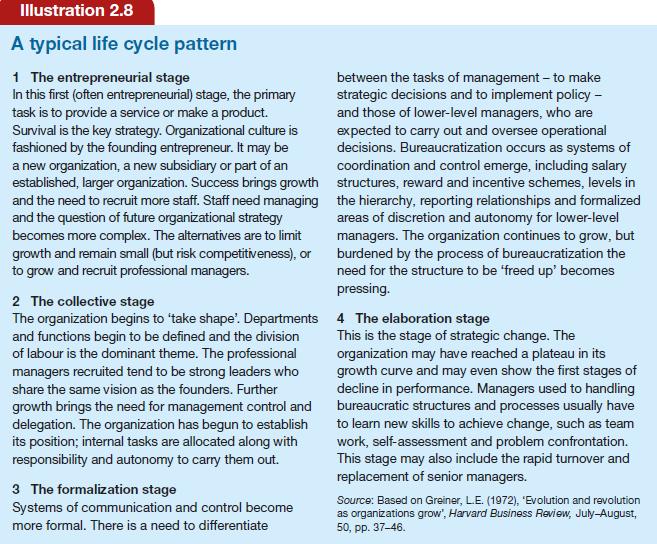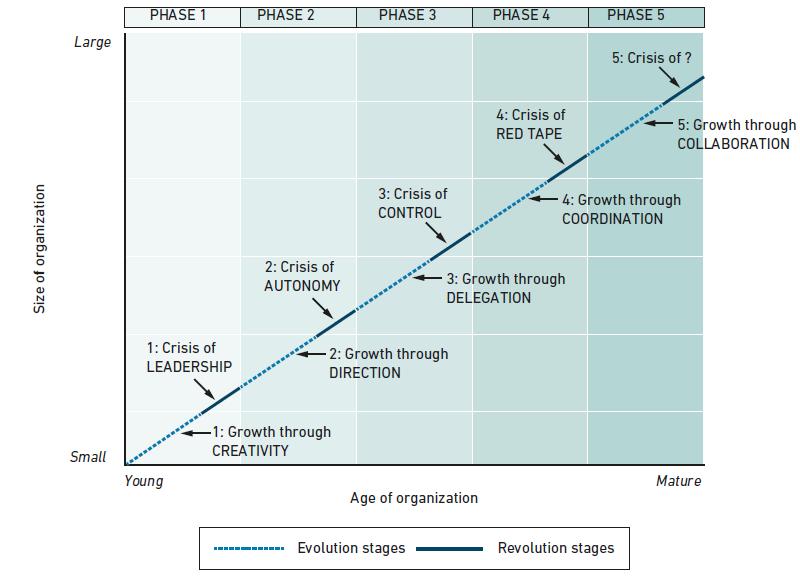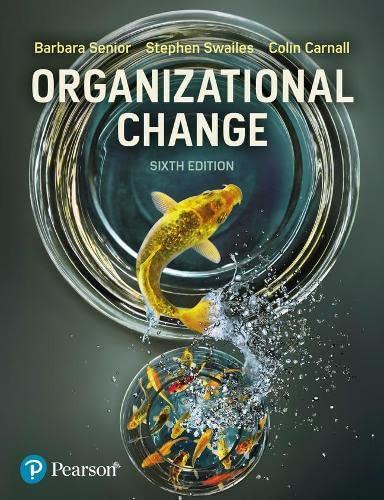Consider an organization you know well. Using the descriptions in Illustration 2.8 and Table 2.1 , position
Question:
Consider an organization you know well. Using the descriptions in Illustration 2.8 and Table 2.1 , position the organization on the graph in Figure 2.4 .
Table 2.1
Figure 2.4
Transcribed Image Text:
Illustration 2.8 A typical life cycle pattern 1 The entrepreneurial stage In this first (often entrepreneurial) stage, the primary task is to provide a service or make a product. Survival is the key strategy. Organizational culture is fashioned by the founding entrepreneur. It may be a new organization, a new subsidiary or part of an established, larger organization. Success brings growth and the need to recruit more staff. Staff need managing and the question of future organizational strategy becomes more complex. The alternatives are to limit growth and remain small (but risk competitiveness), or to grow and recruit professional managers. 2 The collective stage The organization begins to 'take shape'. Departments and functions begin to be defined and the division of labour is the dominant theme. The professional managers recruited tend to be strong leaders who share the same vision as the founders. Further growth brings the need for management control and delegation. The organization has begun to establish its position; internal tasks are allocated along with responsibility and autonomy to carry them out. 3 The formalization stage Systems of communication and control become more formal. There is a need to differentiate between the tasks of management - to make strategic decisions and to implement policy - and those of lower-level managers, who are expected to carry out and oversee operational decisions. Bureaucratization occurs as systems of coordination and control emerge, including salary structures, reward and incentive schemes, levels in the hierarchy, reporting relationships and formalized areas of discretion and autonomy for lower-level managers. The organization continues to grow, but burdened by the process of bureaucratization the need for the structure to be 'freed up' becomes pressing. 4 The elaboration stage This is the stage of strategic change. The organization may have reached a plateau in its growth curve and may even show the first stages of decline in performance. Managers used to handling bureaucratic structures and processes usually have to learn new skills to achieve change, such as team work, self-assessment and problem confrontation. This stage may also include the rapid turnover and replacement of senior managers. Source: Based on Greiner, L.E. (1972), 'Evolution and revolution as organizations grow", Harvard Business Review, July-August, 50, pp. 37-46.
Step by Step Answer:

This question has not been answered yet.
You can Ask your question!
Related Book For 

Organizational Change
ISBN: 9781292243436
6th Edition
Authors: Barbara Senior, Stephen Swailes, Colin Carnall
Question Posted:
Students also viewed these Business questions
-
1 Using the descriptions in Illustration 2.12 , identify three difficulties you have faced at work or in similar situations elsewhere. 2 Identify two or three messes you have faced or been involved...
-
Planning is one of the most important management functions in any business. A front office managers first step in planning should involve determine the departments goals. Planning also includes...
-
List three specific parts of the Case Guide, Objectives and Strategy Section (See below) that you had the most difficulty understanding. Describe your current understanding of these parts. Provide...
-
One end of a light, elastic string, of natural length 1.2m and modulus of elasticity 32N, is attached to a fixed point, B. A particle, P, of mass 1.5 kg, is then attached to the other end of the...
-
Why the difference?
-
Air Links, a commuter airline company, is considering replacing one of its baggage-handling machines with a newer and more efficient one. The current book value of the old machine is $50,000, and it...
-
A cost seeking to create and stimulate demand and secure orders is (a) Distribution cost (b) Selling cost (c) Administrative cost (d) Research cost
-
Elvin, 45 years of age, sells his residence in 2014. He receives $30,000 in cash, and the buyer assumes his $105,000 mortgage. Elvin also pays $6,500 in commissions and transfer costs. a. Calculate...
-
Please answer question #5, SHOWING ALL WORK ACCORDINGLY. Thank you! Vaughn is a corporation that sells breakfast cereal. Based on the accounts listed below, what are Vaughn's total trade receivables?...
-
This activity will help identify the routines, rituals and symbols prevalent in an organization and who uses them. Think of your own organization, or one you are familiar with. 1. Which routines and...
-
Think of someone whom you consider does their job very well, but who has been unsuccessful in getting promotion. Assuming there is no reason why this person could not do the higher-level job (given...
-
A debtor owing payments of $750 due today, $1000 due in 2 years, and $1250 due in 4 years requests a payout figure to settle all three obligations by means of a single economically equivalent payment...
-
1. A corn farmer has observed the following distribution for the number of ears of corn per cornstalk. Ears of Corn Probability 1 2 3 4 .3 .4 .2 .1 Part A: How many ears of corn does he expect on...
-
1. A mass m on a vertical spring with force constant k has an amplitude of A. Using the top of the motion as the origin for both gravitational potential energy and spring potential energy: (a) Find...
-
2. Consider the PDE Utt - Uxx + Ut - Ux = 0 (1) for < < and 0
-
On April 1, 2024, Chardonnay pays an insurance company $12,480 for a two- year fire insurance policy. The entire $12,480 is debited to Prepaid Insurance at the time of the purchase. Record the...
-
Which retailer(s) should represent and sell your product?Why?In terms of their range of distribution coverage, is your retailer intensive, selective and exclusive? Why is this aspect important to...
-
Matter's outstanding bond issue has a coupon rate of 10%, and it sells at a yield to maturity of 9.25%. The firm wishes to issue additional bonds to the public at face value. What coupon rate must...
-
The Ferris wheel in the figure has a radius of 68 feet. The clearance between the wheel and the ground is 14 feet. The rectangular coordinate system shown has its origin on the ground directly below...
-
To what extent do organizational messes get treated as if they were difficulties? What are the organizational consequences of this? Does it matter how change situations are classified?
-
Take each example you thought of in Activity 2.4 and make a judgement as to whether your example is, overall, a hard or soft problem/change situation. Did the activity confirm or refute your...
-
To what extent do you think the environmental scanning tools are effective in diagnosing the environment for organizations? Are there situations when they might not be effective?
-
please help Problem 13-7 (Algo) Prepare a Statement of Cash Flows [LO13-1, LO13-2] [The following information applies to the questions displayed below.] Comparative financial statements for Weaver...
-
A firm has 1000 shareholders, each of whom own $59 in shares. The firm uses $28000 to repurchase shares. What percentage of the firm did each of the remaining shareholders own before the repurchase,...
-
Vancouver Bank agrees to lend $ 180,000 to Surrey Corp. on November 1, 2020 and the company signs a six-month, 6% note maturing on May 1, 2021. Surrey Corp. follows IFRS and has a December 31 fiscal...

Study smarter with the SolutionInn App


